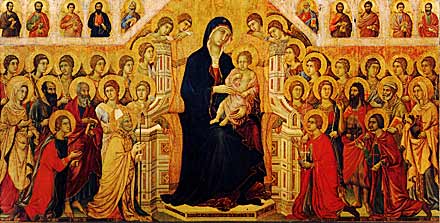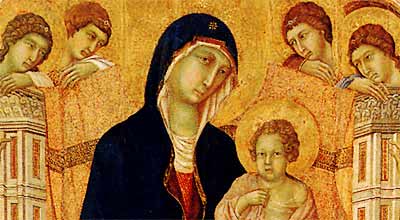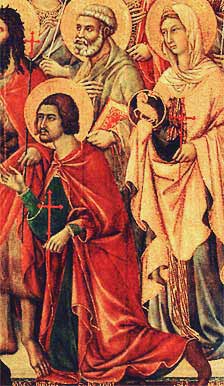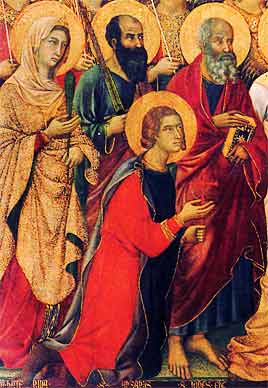
Duccio di Buoninsegna
Maestà (central panel)

"Oh, Holy Mother of God, grant peace to Siena, grant life to Duccio, since he has painted you thus."
≈ Duccio, inscribed on
throne in his Maestà
Duccio di Buoninsegna (ca. 1255 – ca. 1319) was the first great painter of Siena. Like Cimabue, in whose workshop he apprenticed, Duccio was a master of stylized Byzantine painting, yet he brought an inspired, more modern style to his work -- a style which reached its greatest expression in his Maestà, a majestic altarpiece in which expressive line and lyrical style helped lead a shift in focus from illustration to narrative storytelling in Western art.
Though revered as an artist, Duccio had a restless temperament and lived
detail 1: With a new expressiveness, Duccio
abandoned the rigid postures of traditional
Byzantine painting an unruly life with a rebellious attitude toward public authority. He was cited for infractions from trespassing to a refusal to fulfill his military duties. He had a particular difficulty managing money, as evidenced by the many records of municipal fines and debts.
His great, gilded altarpiece was commisioned to glorify the Madonna, considered the Protectoress of Siena after its unlikely victory over the Florentines in the battle in 1260. At 14 1/2' by 7 1/2', painted both front and back, it was the largest painting of its time. The execution of this composition, which covered both sides of the massive panel, was an enormous undertaking for Duccio and his apprentices. Three full years in the making, it was completed in 1311 and installed on the high altar of the city's Cathedral.
The front side, known as The Mother of God Enthroned with the Christ Child Amidst Angels and Saints,
detail 2: Duccios's elegant lines
and curves, and the softness of
his fabrics includes 20 angels and 20 saints, including John the Baptist, Peter, Agnes, John the Evengelist, Paul and Catherine of Alexandria, as well as figures of other Apostles within the top arches.
The positions and gestures of the many figures around the throne seem to take on an architecural structure with a clear succession of planes -- from the bottom plane, depicting the patron saints of Siena, up to the top plane containing angels contemplating the Virgin -- moving from earthly to heavenly forms.
Standing in front of the altarpiece, the scale of the monumental Madonna (which, as in Byzantine painting, is much larger then the other figures) fills the visual field, as the saints seem to recede. Accentuating this, the inlaid marble throne is placed in a completely frontal position, splayed out like an open book, imparting a sense of depth to the scene. Yet Duccio paints the Virgin as tender and human, giving Her a slight inclination of the head and lowered glance -- as though she actually hears the prayers of the faithful, kneeling at her feet.
The Christ child, though not entirely child-like in appearance, is much more natural-looking here than in earlier icons. He is neither playing nor turning toward his mother, nor is his hand outstretched in the traditional gesture of blessing.
detail 3: Duccio uses a wide range of
delicate, original hues, initiating a
Sienese infatuation with color
In Duccio's vision, he sits comfortably, but with dignity, helping to focus all attention on the Virgin.
As in most of Duccio's work, there is a wistful, melancholy feeling, as seen, for instance, in the angels laying of hands on the throne, which frames and sets off the tender, elongated hands of Mother and Child. With every character, there is an emphasis on delicacy and grace of body, faces and hands which exhibit a subtle three-dimensional quality. Figures seem to communicate with tender glances. Even the draperies have a realistic softness, compared with the abstract folds in garments of Byzantine-era figures. To all his panels, Duccio brought a great awareness of closely-observed, humanistic imagery.
Another hallmark of Duccio's work was his innovation with color, in which he achieved a new warmth and rhythmic subtlety. Devising original tints and hues, he was able to impart a purity and luminosity of tone, as seen in the deep, midnight blue of the Madonna's robe, the incised halos and elaborate gold stenciling of the Child's violet-colored mantle, and the play of pattern and colored drapery across the panel set off by the tooled gold and halos of the angels wings.
The inscription on the bottom of the throne seems to symbolize the feeling of the artist that he had created a masterpiece, as he claimed special protection from the Virgin, in return for painting her so beautifully.
Apart from sheer technical skill, Duccio's work introduced a grace and suppleness to the figures as well as a new range and depth of emotion. Though Sienese painters were not as advanced in terms of three-dimensional perspective as were Florentine contemporaries such as Giotto, Duccio led the way with his novel and vivid observation of life, warmth of color, rhythmic subtlety and intense depiction of human feeling.
